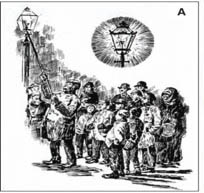Mantles and Arc Lamps
 One interesting, early example of thorium’s utility can be traced to its usage as a mantle material in Welsbach mantles for street lighting. This principle of heating Rare-Earth metallic salts (which oxidize after initial ignition) or various oxides so as to produce bright light is called candoluminescence, made famous in the early 1800s with so-called limelights. Regardless of the material (calcium oxide (limelight), rare-earth salts or thorium dioxide), the principle is the same.
One interesting, early example of thorium’s utility can be traced to its usage as a mantle material in Welsbach mantles for street lighting. This principle of heating Rare-Earth metallic salts (which oxidize after initial ignition) or various oxides so as to produce bright light is called candoluminescence, made famous in the early 1800s with so-called limelights. Regardless of the material (calcium oxide (limelight), rare-earth salts or thorium dioxide), the principle is the same.
In candoluminescence, photonic flux for particular materials at high temperatures is high in the visible range of the electromagnetic spectrum. As such, unusually bright, white light is emitted. The use of calcium oxide limelights became largely specific to theatrical performances, having preceded the discovery of thoria-driven candoluminescence by several decades.
References:
- B. Bowers,Lengthening the Day(Oxford Univ. Press,Oxford, 1998).
- Killing, C. Incandescent Gas Lighting. Progressive Age. Harbrace Publications. Vol. 15 pp 159-161. 1897.
- Elliot, E.L. Good Lighting and the Illuminating Engineer: Vol. 2 Illuminating Engineering Publishing Co. 994 Pages. 1908.
- Swan, R.L. Catalytic effects of the oxides of cerium and thorium, and their bearing on the theory of the Welsbach mantle. J. Chem. Soc., Trans.,125, 780-785. 1924
- Pfund, A.H. The Electric Welsbach Lamp. J. Opt. Soc. Am. 26, 439-442 (1936)


